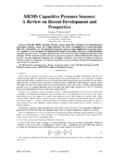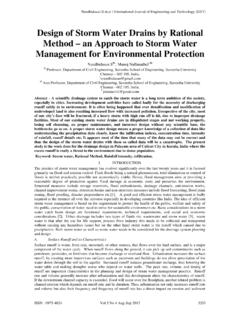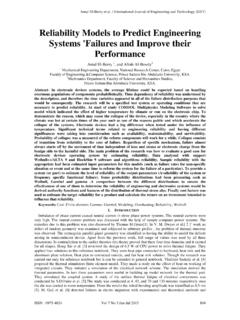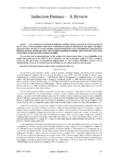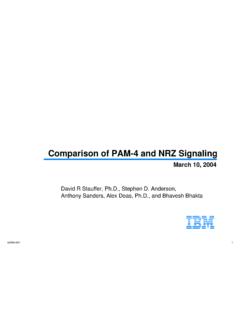Transcription of Comparison of Efficiencies of Solar Tracker systems with ...
1 Et al. / International Journal of Engineering and Technology (IJET). Comparison of Efficiencies of Solar Tracker systems with static panel Single- Axis Tracking system and Dual-Axis Tracking system with Fixed Mount , , , , , 1. Professor,VLSI Division, SENSE, VIT UNIVERSITY, Vellore-632014,TN,India. 1. 2. GGR college of engineering, Tamilnadu, India . 2. 3,4,5. Electronics and Communications Engineering, SENSE, VIT UNIVERSITY, Vellore-632014,TN,India. 3. 6. SRM University,Chennai,Tamilnadu,India. Abstract Electricity plays a key role now in our daily lives but the energy sources to electric power has been used in abundance and so researchers were compelled to find an alternate source of power leading to the discovery of Solar energy. Solar energy is inexhaustible and eco-friendly and can be converted into electricity using photovoltaic panels. These panels can be used in a fixed form or used in a Solar tracking system for single axis as well as for dual axis.
2 In a fixed form their efficiency is low since the panels will be tilted in a particular angle whereas in a tracking system the panel is made to move either in single axis or dual axis. In a single axis system the panel is moved in an east to west direction with respect to the sun and it has better efficiency than panels in fixed form. But in a dual axis system the panel is made to rotate in all four directions in accordance with the sun. And dual axis has proved to have more efficiency than both fixed panels and single axis system . Index Terms Dual-axis Solar Tracker , Efficiency, Fixed mount Solar system , Single-axis Solar Tracker , Solar energy. INTRODUCTION. Today the world is unimaginable without electricity such is the impact of electric power. It is the key to many technologies that had been developed over the years. In the process of converting Solar energy to electricity we use photovoltaic panels which consist of silicon made Solar cells.
3 Photovoltaic effect is the concept used in the panels where light energy due to the sun's radiation is converted into electric power. The conversion of Solar energy into electric power also depends on the angle at which the panel is fixed or made to rotate. There are two types of panel usage: 1) In fixed form and 2) In Solar trackers. When a panel is fixed they are tilted in ground or on a roof at an angle appropriate for sun's radiation. In Solar trackers the panel is made to rotate in the directions with respect to sun. We have experimentally verified that the efficiency and the output power of dual axis system are higher when compared to fixed panel and single axis Solar Tracker system . SINGLE AXIS Tracker . A Single axis tracking system is a method where the Solar panel tracks the sun from east to west using a single pivot point to rotate. Under this system there are three types: horizontal single axis tracking system , vertical single axis tracking system and Tilted single axis tracking system .
4 In the horizontal system the axis of rotation is horizontal with respect to the ground, and the face of the module is oriented parallel to the axis of rotation. In the vertical system the axis of rotation is vertical with respect to the ground and the face of the module is oriented at an angle with respect to the axis of rotation. In the Tilted tracking system the axes of rotation is ISSN : 0975-4024 Vol 5 No 2 Apr-May 2013 1925. et al. / International Journal of Engineering and Technology (IJET). between horizontal and vertical axes and this also has the face of the module oriented parallel to the axis of rotation, similar to the horizontal tracking system . The single axis tracking system consist of two LDR's placed on either side of the panel. Depending on the intensity of the sun rays one of the two LDR's will be shadowed and the other will be illuminated[1].The LDR with the maximum intensity of the sun's radiation sends stronger signal to the controller which inturn sends signal to the motor to rotate the panel in the direction in which the sun's intensity is maximum.
5 Figure 1. Single-Axis Tracker [1]. Figure 3. Block Diagram for Single Axis Tracker A. Efficiency Of Single-Axis Tracking system over Fixed Mount The readings for both the static panel and single-axis Tracker are taken for a single day from morning 8 am to evening 6 pm for every one hour. The following readings are tabulated and a graph was generated using MATLAB as follows ISSN : 0975-4024 Vol 5 No 2 Apr-May 2013 1926. et al. / International Journal of Engineering and Technology (IJET). TABLE I. Comparison OF FIXED MOUNT WITH SINGLE AXIS Tracker system . Hours Static Panel Solar Tracking (Single Axis). V mA mW V mA mW. AM AM AM AM PM PM PM PM PM PM PM Average Power The efficiency of the single axis tracking system over that of the static panel is calculated to be B. Disadvantage The main disadvantage of the single axis Tracker is that it can only track the daily movement of the sun and not the yearly movement.
6 The efficiency of the single axis tracking system is also reduced during cloudy days since it can only track the east-west movement of the sun. DUAL AXIS Solar TRACKING system . Dual axis tracking system uses the Solar panel to track the sun from east to west and north to south using two pivot points to rotate. The dual axis tracking system uses four LDR's, two motors and a controller. The four LDR's are placed at four different directions. One set of sensors and one motor is used to tilt the Tracker in sun's east - west direction and the other set of sensors and the other motor which is fixed at the bottom of the Tracker ISSN : 0975-4024 Vol 5 No 2 Apr-May 2013 1927. et al. / International Journal of Engineering and Technology (IJET). is used to tilt the Tracker in the sun's north-south direction [1]. The controller detects the signal from the LDR's and commands the motor to rotate the panel in respective direction.
7 Figure 4. Dual Axis Tracker [1]. Figure 5. Block Diagram for Dual Axis Tracker [1]. ISSN : 0975-4024 Vol 5 No 2 Apr-May 2013 1928. et al. / International Journal of Engineering and Technology (IJET). C. Experimental Setup D. Efficiency of Dual-Axis Tracking system over Fixed Mount The readings for both the static panel and dual-axis Tracker are taken for from morning 8 am to evening 6 pm for every one hour. The following readings are tabulated and a graph was generated using MATLAB as follows Hours Static Panel Solar Tracking (Dual Axis). V mA mW V mA mW. AM AM AM AM PM PM PM PM PM PM PM Average Power ISSN : 0975-4024 Vol 5 No 2 Apr-May 2013 1929. et al. / International Journal of Engineering and Technology (IJET). Efficiency of Dual-Axis Tracking system over Static panel HOUR POWER FOR POWER. FIXED FOR. MOUNT(mW) SINGLE- AXIS(mW). 0800 0900 1000 1100 1200 1300 1400 1500 1600 1700 1800 TABLE I.
8 FIXED VS SINGLE-AXIS [1]. ISSN : 0975-4024 Vol 5 No 2 Apr-May 2013 1930. et al. / International Journal of Engineering and Technology (IJET). 140. Fixed single Tracker 120. 100. Output Power(W). 80. 60. 40. 20. 8 9 10 11 12 13 14 15 16 17 18. Time Simulation Result for Comparison of Fixed mount and Single-Axis Tracker system [1]. TABLE 2. FIXED VS DUAL-AXIS [2]. HOUR POWER FOR POWER FOR. FIXED DUAL-AXIS(W). MOUNT(W). 0700 38. 0800 0900 1000 1100 52 1200 1300 1400 1500 1600 1700 1800 1900 ISSN : 0975-4024 Vol 5 No 2 Apr-May 2013 1931. et al. / International Journal of Engineering and Technology (IJET). 60. 55. 50. 45. Output Power(W). 40. 35. 30. 25. 20. 15 Fixed Dual Tracker 10. 6 8 10 12 14 16 18 20. Time Fig. Simulation Result for Comparison of Fixed Mount and Dual Axis Tracker system [1]. The efficiency of the dual axis tracking system over that of the static panel is calculated to be Future Work The efficiency of the dual-axis tracking system can be increased even more by placing a mirror or concave lens on top of the panel.
9 The use of lens or mirror increases the Tracker 's efficiency since large amount of sunlight is concentrated on the panel and large power is generated. It can also reduce the size of the Solar cell required to generate large power. It also has high optical efficiency. Conclusion The proposed model of the dual axis Solar Tracker is capable of tracking the sun throughout the year. The dual axis Tracker provides higher output power when compared to single axis Tracker and fixed panel. According to the measured readings the efficiency of the dual axis Tracker is found to be higher than that of fixed panel whereas the efficiency of the single axis Tracker is only higher than that of fixed panel. REFERENCES. [1] , , , R Dhanabal, Comparison of Efficiencies of Single-Axis Tracking system and Dual-Axis Tracking system with Fixed Mount , International Journal of Engineering Science and Innovative Technology (IJESIT), Volume 2, Issue 2, March 2013.
10 [2] Sanzidur Rahman, Rashid Ahammed Ferdaus, Mohammad Abdul Mannan, Mahir Asif Mohammed, Design & Implementation of a Dual Axis Solar Tracking system , American Academic & Scholarly Research Journal Vol. 5, No. 1, Jan. 2013. [3] A. Kassem, M. Hamad, A Microcontroller-Based Multi-Function Solar Tracking system , IEEE 2011. [4] Arindam Bose, Sounak Sarkar, Sayan Das, Helianthus - a Low Cost High Efficient Solar Tracking system Using AVR. Microcontroller , International Journal of Scientific & Engineering Research, Volume 3, Issue 10, October-2012. [5] Lwin Lwin Oo, Nang Kaythi Hlaing, Microcontroller-Based Two-Axis Solar Tracking system , Second International Conference on Computer Research and Development, 2010 IEEE. AUTHOR PROFILES: , Assistant professor (Sr) in SENSE, Vellore Institute of Technology,Vellore, received the degree in Electronics and Communication Engineering from Bharathidasan University, Tiruchirappalli, Tamil Nadu, India in 2001, and degree in VLSI Design from SASTRA University, Tanjore, Tamilnadu, India in 2002.
